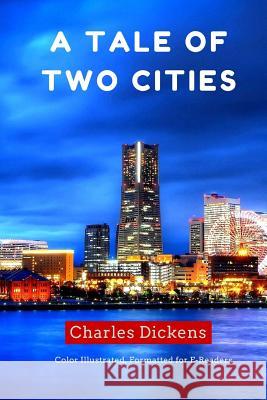A Tale of Two Cities: Color Illustrated, Formatted for E-Readers » książka
A Tale of Two Cities: Color Illustrated, Formatted for E-Readers
ISBN-13: 9781515320197 / Angielski / Miękka / 2015 / 728 str.
Unabridged & Original version. Includes: 30 Colored Illustrations and Biography A Tale of Two Cities (1859) is a novel by Charles Dickens, set in London and Paris before and during the French Revolution. The novel depicts the plight of the French peasantry demoralised by the French aristocracy in the years leading up to the revolution, the corresponding brutality demonstrated by the revolutionaries toward the former aristocrats in the early years of the revolution, and many unflattering social parallels with life in London during the same period. It follows the lives of several characters through these events. A Tale of Two Cities was published in weekly installments from April 1859 to November 1859 in Dickens's new literary periodical titled All the Year Round. All but three of Dickens's previous novels had appeared only as monthly installments. With sales of about 200 million copies, A Tale of Two Cities is the biggest selling novel of all time. Dickens's famous opening sentence introduces the universal approach of the book, the French Revolution, and the drama depicted within: -It was the best of times, it was the worst of times, it was the age of wisdom, it was the age of foolishness, it was the epoch of belief, it was the epoch of incredulity, it was the season of Light, it was the season of Darkness, it was the spring of hope, it was the winter of despair, we had everything before us, we had nothing before us, we were all going direct to Heaven, we were all going direct the other way - in short, the period was so far like the present period, that some of its noisiest authorities insisted on its being received, for good or for evil, in the superlative degree of comparison only. Dickens's famous opening sentence introduces the universal approach of the book, the French Revolution, and the drama depicted within: -It was the best of times, it was the worst of times, it was the age of wisdom, it was the age of foolishness, it was the epoch of belief, it was the epoch of incredulity, it was the season of Light, it was the season of Darkness, it was the spring of hope, it was the winter of despair, we had everything before us, we had nothing before us, we were all going direct to Heaven, we were all going direct the other way - in short, the period was so far like the present period, that some of its noisiest authorities insisted on its being received, for good or for evil, in the superlative degree of comparison only. As a result of his long imprisonment, Dr. Manette suffers a form of psychosis, an obsession with making shoes, a skill he learned in prison to distract himself from his thoughts. At first, he does not recognise his daughter, whose existence he was unaware of; but he eventually recognises her similarity to her mother, through her blue eyes and long golden hair (a strand of which he found on his sleeve when he was incarcerated). Mr. Lorry and Miss Manette take Dr. Manette back with them to England. The novel concludes with the guillotining of Sydney Carton. As he is waiting to board the tumbril, he is approached by a seamstress, also condemned to death, who mistakes him for Darnay but, upon getting close, realises the truth. Awed by his unselfish courage and sacrifice, she asks to stay close to him and he agrees. Upon their arrival at the guillotine, Carton comforts her, telling her that their ends will be quick but that there is no Time or Trouble -in the better land where ... they] will be mercifully sheltered-, and she is able to meet her death in peace.
Zawartość książki może nie spełniać oczekiwań – reklamacje nie obejmują treści, która mogła nie być redakcyjnie ani merytorycznie opracowana.











